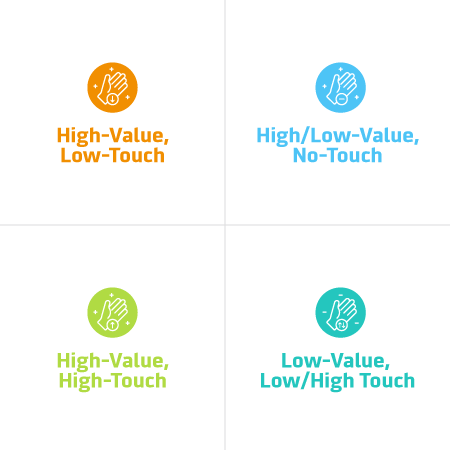Should Manufacturers Hire or Automate to Increase Efficiency & Sales?
 Austin
|
Austin
|

Automating repetitive tasks improves efficiency, boosts productivity, and enables sales staff to build relationships.
Inefficiency can stem from employees spending time on mundane tasks, inadvertently leaving critical, high-impact efforts like relationship building behind in the dust. Over time, this makes employees feel frustrated and defeated because they’re overworked and continually falling short of their sales goals. Too much time is wasted entering data and sending emails, and not enough time is spent on the activities that move the needle.
We understand many companies struggle with inefficiency and unproductiveness like this. Heck, many of our successful manufacturing clients have been there. Pack Leader USA, for instance, felt their sales processes were leaving potential business on the table, so we worked with them to streamline their processes. Within months of making these changes, they were closing 75% more deals with their existing sales team. They increased their sales without adding a single salesperson to their team — that's efficiency and productivity at its best. Plus, it makes for happy employees and a happy business owner.
There are many ways to tackle inefficient processes, but we'll highlight one that we believe is an instant win: automation. The goal is to put you in control and give your employees the focus they need to get the important work done.
Where do I start?
"Where do I start?" is a common question I get when discussing inefficiencies and stalled processes with clients. The solution is actually a lot simpler than it may seem. We boil it down to three simple steps: identify repetitive tasks, determine which tasks are a good fit for automation, and set up your automation processes.
Step 1: Identify repetitive tasks.
It may not seem obvious at first, but many of your employee's tasks are repetitive: writing identical emails, filling out the same form, or checking the same box. These are great places to start.
Determine where you're feeling the most inefficiencies, whether it's sales, service, or marketing, then start with that team. Have a discussion. Find out what people are complaining about or what job no one wants to do. These are often ideal tasks to automate. For instance, a salesperson sends a follow-up email to every prospect they get. Even though they're personalized, these emails are probably very similar, so why not automate or create a template for that email? Doing this will save time for the salesperson, allowing them to talk to more prospects.
Take a few minutes to brainstorm all the potential tasks that you could automate — be sure to write everything down as there are no wrong answers.
Step 2: Determine what’s a good fit for automation.
In this step, we’ll look at each task individually to determine if it requires a human touch, needs some interaction, or could be fully automated. Let's dig into those just a little bit more.
 High-Value, High-Touch/Needs Human Interaction: One of the worst things that can happen is when a customer expecting contact with a human gets an obviously automated response. I have seen this happen across the board, from sales to service. Let's be honest; not every task can be automated. Sometimes human interaction is necessary beyond a CRM personalization token. These types of tasks often have high value to the company, like a proposal or quote review with the client, and need a high level of touch from your team. I suggest bucketing those into a column that stays high-value, high-touch.
High-Value, High-Touch/Needs Human Interaction: One of the worst things that can happen is when a customer expecting contact with a human gets an obviously automated response. I have seen this happen across the board, from sales to service. Let's be honest; not every task can be automated. Sometimes human interaction is necessary beyond a CRM personalization token. These types of tasks often have high value to the company, like a proposal or quote review with the client, and need a high level of touch from your team. I suggest bucketing those into a column that stays high-value, high-touch.
High-Value, Low-Touch: These tasks often need some human interaction, but it's limited. The follow-up sales email I mentioned earlier is a great example. The body of the email may stay the same from prospect to prospect, but the introduction should be personalized to include things like highlights from your last phone call, reminders, updates, etc. In part, these tasks can be templated and automated to streamline processes and create more efficient use of time.
High-Value, No-Touch & Low-Value, No-Touch: These two categories require little to no interaction from a person. They are simply "set and go." These can include a set of follow-up emails triggered by an action taken by a prospect or tasks automatically created in the CRM to help employees stay engaged with leads. I usually consider these low hanging fruits for automation because they're easy to set up and reap benefits very quickly.
Low-Value, Low/High Touch: I'm not going into much detail about this category because if there isn't much value associated with these tasks, they're likely not necessary. These tasks are better addressed in the overall strategy. If they are deemed worthy of keeping, they will need to be changed to provide more value.
When determining fit for automation, look over this list of varying efforts and values, then start prioritizing. Start with High-Value, No-Touch items followed by High-Value, Low-Touch tasks. Doing this will ensure you're spending time automating the pieces that offer the most value for your time.
Step 3: Set up your automation processes.
Now that you have a list of tasks that can be streamlined, it's time to get automated.
There are many ways to automate, and there are many tools that can get the job done. Start by evaluating the tools you already have at your disposal. There’s a good chance that they can handle some automation tasks, helping you to maximize efforts and streamline efficiency immediately. Depending on the task, you may need to consider additional marketing, sales, or service tools.

If you don't currently have sales automation software or you're looking to upgrade to a robust system with more functionality, browse this list from G2, a trustworthy tech marketplace with helpful reviews and insightful product analysis.
As a Platinum HubSpot Partner, we most often choose to use HubSpot's tools for automation tasks. HubSpot Sales Hub, in particular, has automation capabilities and sales engagement tools built on top of their powerful and easy-to-use sales CRM. Here’s an example of how we use HubSpot’s automation to streamline processes.
Summary
To help you get started, we can discuss different steps and ideas in your company's sales tasks and determine which require a human touch, need only some interaction, or could be fully automated. Once you've done that, you'll be able to determine if your current software can accomplish the level of automation you need or if you need to look for an alternative that would better suit your needs.
If taking this on yourself still seems like a mountain you don't want to climb alone, start a conversation with us. We're happy to help you find the automation software that meets your needs and fits in your budget.
Don’t let the day-to-day tasks overwhelm your team, leaving them drained and unfocused. Automation done right will free up your employees to do the things that only they can do, which will lead to more closed sales. Developing ways to streamline processes and improve efficiencies can move you one step closer to increasing sales without hiring more team members — just like Pack Leader USA.
Empowering your employees by setting them up for success is an essential building block to a happier workforce, happier clients, and a happier owner — you!
Subscribe to Our Blog
Stay up to date with the latest marketing, sales, and service tips.


